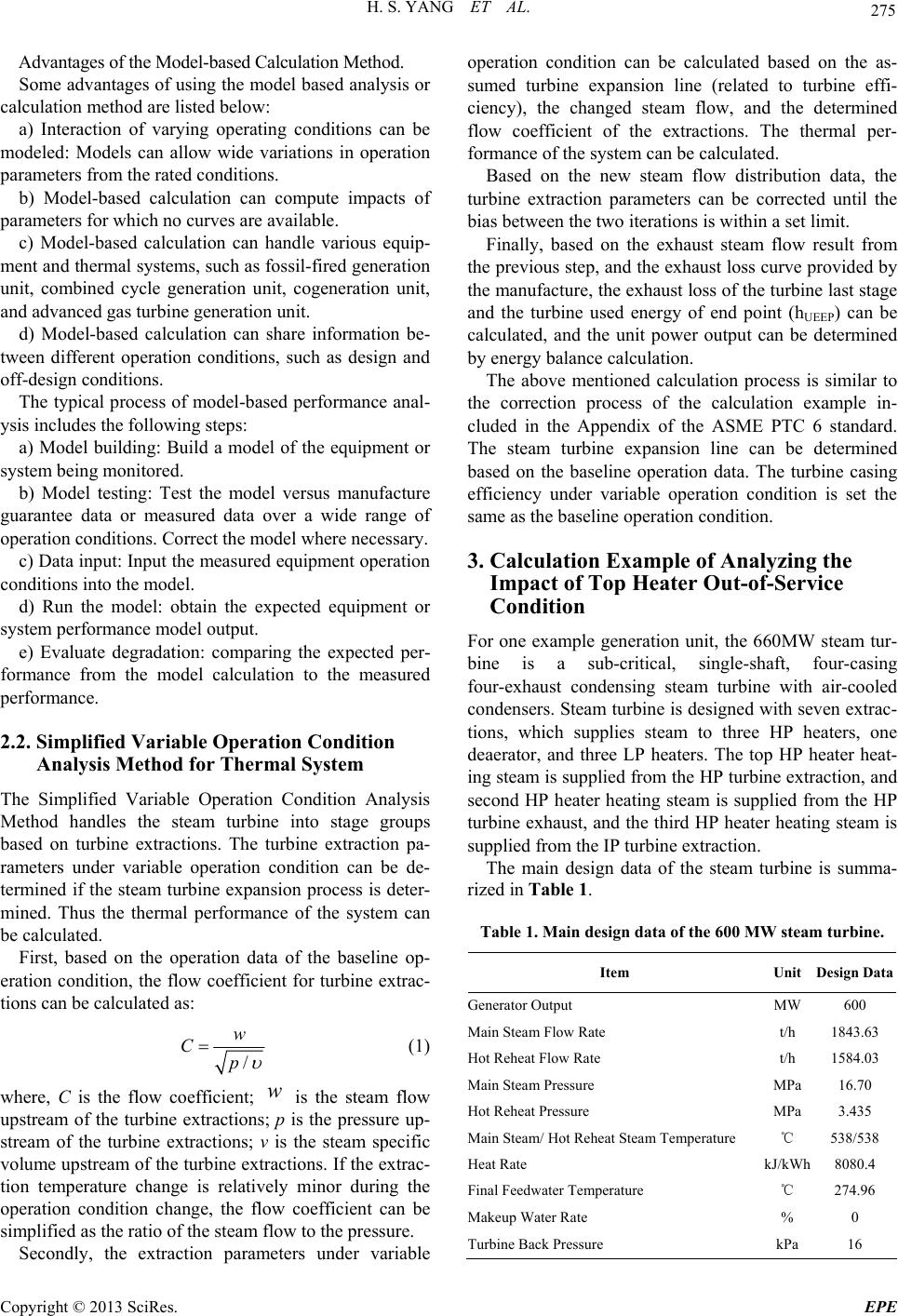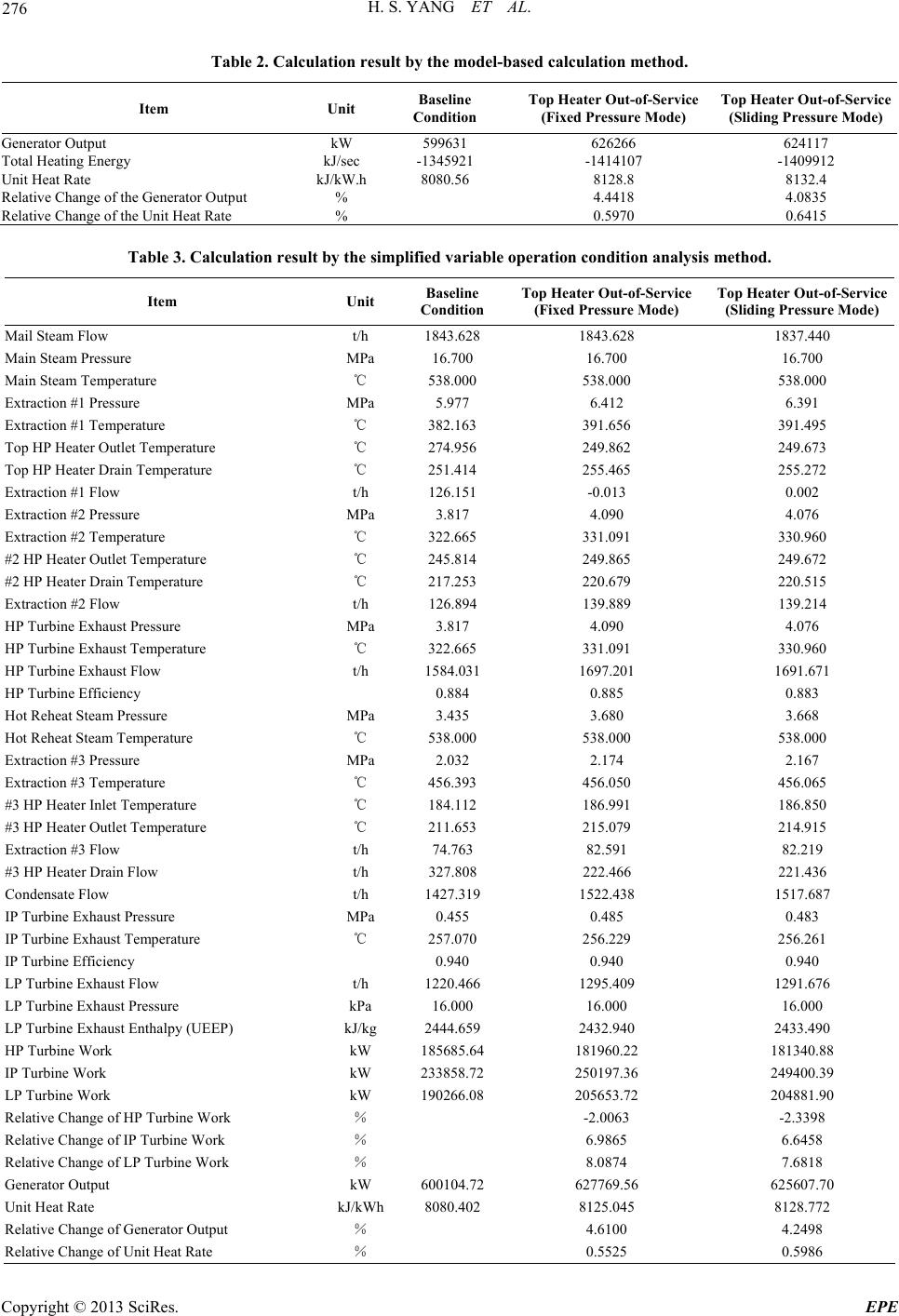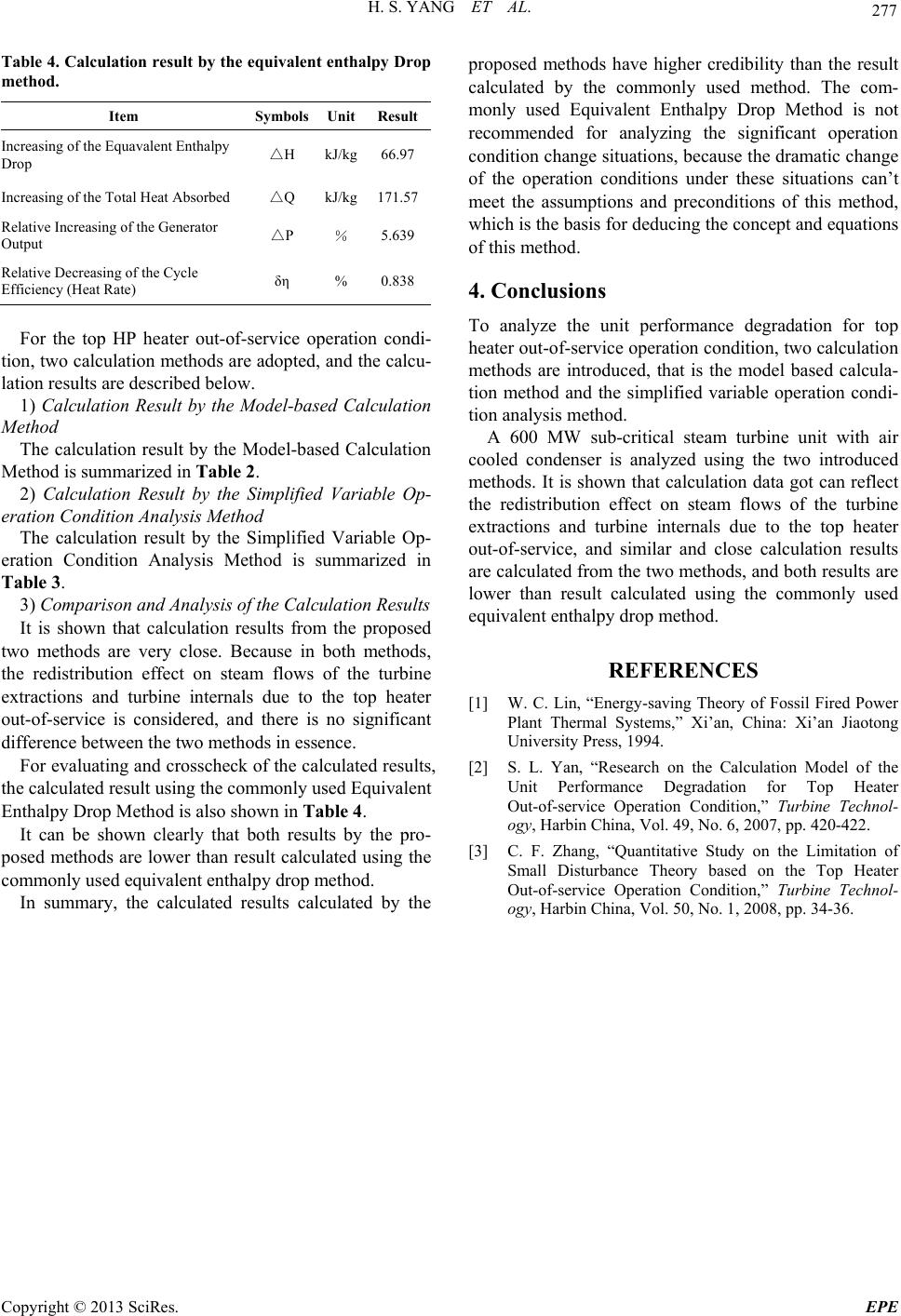Paper Menu >>
Journal Menu >>
 Energy and Power Engineering, 2013, 5, 274-277 doi:10.4236/epe.2013.54B053 Published Online July 2013 (http://www.scirp.org/journal/epe) Analysis of the Unit Performance Degradation for Top Heater Out-of-service Operation Condition Haisheng Yang, Shuping Chang, Ruitao Wu Thermal Technology Depart, Hebei Electric Power Research Institute, Shijiazhuang, Hebei PRC Email: haisheng.yang@gmail.com, hbdyycsp@163.com, hbdyywrt@163.com Received September, 2012 ABSTRACT To analyze the unit performance degradation for top heater out-of-service operation condition, two calculation methods were introduced, that was the model based calculation method and the simplified variable operation condition analysis method. A 600MW sub-critical steam turbine unit with air cooled condenser was analyzed using the two introduced methods. It is shown that calculation data got can reflect the redistribution effect on steam flows of the turbine extrac- tions and turbine internals due to the top heater out-of-service, and similar and close calculation results were got from the two methods, and both results were lower than result calculated using the commonly used equivalent enthalpy drop method. Keywords: Top Heater; Out-of-service; Performance Degradation; Analysis Method 1. Introduction Presently the Equivalent Enthalpy Drop Method is com- monly used in the performance quantitative analysis of the steam turbine units. For the top heater out-of-service operation condition for the steam turbine unit, the quan- titative analysis equation in [1] is widely used to deter- mine the effect on unit performance. In Ref [2], the impact of top heater out-of-service con- dition was analyzed under the consumption that the top heater out-of-service operation was a small disturbance to the normal operation conditions. In Ref [3], the impact of top heater out-of-service condition was calculated by the Variable Operation Condition Analysis Method and Matrix Method (based on the small disturbance con- sumption), and it was concluded that there was minor difference between the two calculated results. Theoretically, the Equivalent Enthalpy Drop Method is based on the certain assumption, that is the parameters of the live steam, reheat steam, the turbine end, and the ex- tractions are kept constant, or the change of the turbine expansion line is not considered. The mentioned assump- tion is the precondition for establishing the concept and equations of the Equivalent Enthalpy Drop Analysis Method. Under practical operation conditions, when the top heater is out-of-service, there is a dramatic change of the unit operation condition and turbine internal flow and parameters. Thus, the Equivalent Enthalpy Drop Method is not very applicable for analysis of this operation con- dition change. 2. Two Calculation Methods for Analyzing the Impact of Top Heater Out-of-Service Condition To analyze the unit performance degradation for top heater out-of-service operation condition, two calculation methods are introduced, that is the Model-based Calcula- tion Method and the Simplified Variable Operation Con- dition Analysis Method. 2.1. The Model-based Calculation Method for Thermal System During normal operation, the operation parameters and the equipment performance are inter-related and coupled. The model-based calculation method can reflect the cou- pling relationship between the equipment performance and the operation conditions, thus provide a clear picture of the influence between the equipment and boundary conditions, especially for operation conditions with large scale change of operation parameters, equipment per- formance and operation loading. Model-based calculation software such as GateCycle, can provide analysis for all various changes of the opera- tion parameters and equipment performance degradation. This method can consider the change factors and its re- lated effect on the thermal system, thus providing an complete variable Operation Condition Analysis for the system. Copyright © 2013 SciRes. EPE  H. S. YANG ET AL. 275 Advantages of the Model-based Calculation Method. Some advantages of using the model based analysis or calculation method are listed below: a) Interaction of varying operating conditions can be modeled: Models can allow wide variations in operation parameters from the rated conditions. b) Model-based calculation can compute impacts of parameters for which no curves are available. c) Model-based calculation can handle various equip- ment and thermal systems, such as fossil-fired generation unit, combined cycle generation unit, cogeneration unit, and advanced gas turbine generation unit. d) Model-based calculation can share information be- tween different operation conditions, such as design and off-design conditions. The typical process of model-based performance anal- ysis includes the following steps: a) Model building: Build a model of the equipment or system being monitored. b) Model testing: Test the model versus manufacture guarantee data or measured data over a wide range of operation conditions. Correct the model where necessary. c) Data input: Input the measured equipment operation conditions into the model. d) Run the model: obtain the expected equipment or system performance model output. e) Evaluate degradation: comparing the expected per- formance from the model calculation to the measured performance. 2.2. Simplified Variable Operation Condition Analysis Method for Thermal System The Simplified Variable Operation Condition Analysis Method handles the steam turbine into stage groups based on turbine extractions. The turbine extraction pa- rameters under variable operation condition can be de- termined if the steam turbine expansion process is deter- mined. Thus the thermal performance of the system can be calculated. First, based on the operation data of the baseline op- eration condition, the flow coefficient for turbine extrac- tions can be calculated as: / w Cp (1) where, C is the flow coefficient; is the steam flow upstream of the turbine extractions; p is the pressure up- stream of the turbine extractions; v is the steam specific volume upstream of the turbine extractions. If the extrac- tion temperature change is relatively minor during the operation condition change, the flow coefficient can be simplified as the ratio of the steam flow to the pressure. w Secondly, the extraction parameters under variable operation condition can be calculated based on the as- sumed turbine expansion line (related to turbine effi- ciency), the changed steam flow, and the determined flow coefficient of the extractions. The thermal per- formance of the system can be calculated. Based on the new steam flow distribution data, the turbine extraction parameters can be corrected until the bias between the two iterations is within a set limit. Finally, based on the exhaust steam flow result from the previous step, and the exhaust loss curve provided by the manufacture, the exhaust loss of the turbine last stage and the turbine used energy of end point (hUEEP) can be calculated, and the unit power output can be determined by energy balance calculation. The above mentioned calculation process is similar to the correction process of the calculation example in- cluded in the Appendix of the ASME PTC 6 standard. The steam turbine expansion line can be determined based on the baseline operation data. The turbine casing efficiency under variable operation condition is set the same as the baseline operation condition. 3. Calculation Example of Analyzing the Impact of Top Heater Out-of-Service Condition For one example generation unit, the 660MW steam tur- bine is a sub-critical, single-shaft, four-casing four-exhaust condensing steam turbine with air-cooled condensers. Steam turbine is designed with seven extrac- tions, which supplies steam to three HP heaters, one deaerator, and three LP heaters. The top HP heater heat- ing steam is supplied from the HP turbine extraction, and second HP heater heating steam is supplied from the HP turbine exhaust, and the third HP heater heating steam is supplied from the IP turbine extraction. The main design data of the steam turbine is summa- rized in Table 1. Table 1. Main design data of the 600 MW steam turbine. Item Unit Design Data Generator Output MW 600 Main Steam Flow Rate t/h 1843.63 Hot Reheat Flow Rate t/h 1584.03 Main Steam Pressure MPa 16.70 Hot Reheat Pressure MPa 3.435 Main Steam/ Hot Reheat Steam Temperature ℃ 538/538 Heat Rate kJ/kWh8080.4 Final Feedwater Temperature ℃ 274.96 Makeup Water Rate % 0 Turbine Back Pressure kPa 16 Copyright © 2013 SciRes. EPE  H. S. YANG ET AL. Copyright © 2013 SciRes. EPE 276 Table 2. Calculation result by the model-based c alculation method. Item Unit Baseline Condition Top Heater Out-of-Service (Fixed Pressure Mode) Top Heater Out-of-Service (Sliding Pressure Mode) Generator Output kW 599631 626266 624117 Total Heating Energy kJ/sec -1345921 -1414107 -1409912 Unit Heat Rate kJ/kW.h8080.56 8128.8 8132.4 Relative Change of the Generator Output % 4.4418 4.0835 Relative Change of the Unit Heat Rate % 0.5970 0.6415 Table 3. Calculation result by the simplified variable operation condition analysis method. Item Unit Baseline Condition Top Heater Out-of-Service (Fixed Pressure Mode) Top Heater Out-of-Service (Sliding Pressure Mode) Mail Steam Flow t/h 1843.628 1843.628 1837.440 Main Steam Pressure MPa 16.700 16.700 16.700 Main Steam Temperature ℃ 538.000 538.000 538.000 Extraction #1 Pressure MPa 5.977 6.412 6.391 Extraction #1 Temperature ℃ 382.163 391.656 391.495 Top HP Heater Outlet Temperature ℃ 274.956 249.862 249.673 Top HP Heater Drain Temperature ℃ 251.414 255.465 255.272 Extraction #1 Flow t/h 126.151 -0.013 0.002 Extraction #2 Pressure MPa 3.817 4.090 4.076 Extraction #2 Temperature ℃ 322.665 331.091 330.960 #2 HP Heater Outlet Temperature ℃ 245.814 249.865 249.672 #2 HP Heater Drain Temperature ℃ 217.253 220.679 220.515 Extraction #2 Flow t/h 126.894 139.889 139.214 HP Turbine Exhaust Pressure MPa 3.817 4.090 4.076 HP Turbine Exhaust Temperature ℃ 322.665 331.091 330.960 HP Turbine Exhaust Flow t/h 1584.031 1697.201 1691.671 HP Turbine Efficiency 0.884 0.885 0.883 Hot Reheat Steam Pressure MPa 3.435 3.680 3.668 Hot Reheat Steam Temperature ℃ 538.000 538.000 538.000 Extraction #3 Pressure MPa 2.032 2.174 2.167 Extraction #3 Temperature ℃ 456.393 456.050 456.065 #3 HP Heater Inlet Temperature ℃ 184.112 186.991 186.850 #3 HP Heater Outlet Temperature ℃ 211.653 215.079 214.915 Extraction #3 Flow t/h 74.763 82.591 82.219 #3 HP Heater Drain Flow t/h 327.808 222.466 221.436 Condensate Flow t/h 1427.319 1522.438 1517.687 IP Turbine Exhaust Pressure MPa 0.455 0.485 0.483 IP Turbine Exhaust Temperature ℃ 257.070 256.229 256.261 IP Turbine Efficiency 0.940 0.940 0.940 LP Turbine Exhaust Flow t/h 1220.466 1295.409 1291.676 LP Turbine Exhaust Pressure kPa 16.000 16.000 16.000 LP Turbine Exhaust Enthalpy (UEEP) kJ/kg 2444.659 2432.940 2433.490 HP Turbine Work kW 185685.64 181960.22 181340.88 IP Turbine Work kW 233858.72 250197.36 249400.39 LP Turbine Work kW 190266.08 205653.72 204881.90 Relative Change of HP Turbine Work % -2.0063 -2.3398 Relative Change of IP Turbine Work % 6.9865 6.6458 Relative Change of LP Turbine Work % 8.0874 7.6818 Generator Output kW 600104.72 627769.56 625607.70 Unit Heat Rate kJ/kWh 8080.402 8125.045 8128.772 Relative Change of Generator Output % 4.6100 4.2498 Relative Change of Unit Heat Rate % 0.5525 0.5986  H. S. YANG ET AL. 277 Table 4. Calculation result by the equivalent enthalpy Drop method. Item Symbols UnitResult Increasing of the Equavalent Enthalpy Drop △H kJ/kg66.97 Increasing of the Total Heat Absorbed △Q kJ/kg171.57 Relative Increasing of the Generator Output △P % 5.639 Relative Decreasing of the Cycle Efficiency (Heat Rate) δη % 0.838 For the top HP heater out-of-service operation condi- tion, two calculation methods are adopted, and the calcu- lation results are described below. 1) Calculation Result by the Model-based Calculation Method The calculation result by the Model-based Calculation Method is summarized in Table 2. 2) Calculation Result by the Simplified Variable Op- eration Condition An alysis Method The calculation result by the Simplified Variable Op- eration Condition Analysis Method is summarized in Table 3. 3) Comparison and Analysis of the Calculation Results It is shown that calculation results from the proposed two methods are very close. Because in both methods, the redistribution effect on steam flows of the turbine extractions and turbine internals due to the top heater out-of-service is considered, and there is no significant difference between the two methods in essence. For evaluating and crosscheck of the calculated results, the calculated result using the commonly used Equivalent Enthalpy Drop Method is also shown in Table 4. It can be shown clearly that both results by the pro- posed methods are lower than result calculated using the commonly used equivalent enthalpy drop method. In summary, the calculated results calculated by the proposed methods have higher credibility than the result calculated by the commonly used method. The com- monly used Equivalent Enthalpy Drop Method is not recommended for analyzing the significant operation condition change situations, because the dramatic change of the operation conditions under these situations can’t meet the assumptions and preconditions of this method, which is the basis for deducing the concept and equations of this method. 4. Conclusions To analyze the unit performance degradation for top heater out-of-service operation condition, two calculation methods are introduced, that is the model based calcula- tion method and the simplified variable operation condi- tion analysis method. A 600 MW sub-critical steam turbine unit with air cooled condenser is analyzed using the two introduced methods. It is shown that calculation data got can reflect the redistribution effect on steam flows of the turbine extractions and turbine internals due to the top heater out-of-service, and similar and close calculation results are calculated from the two methods, and both results are lower than result calculated using the commonly used equivalent enthalpy drop method. REFERENCES [1] W. C. Lin, “Energy-saving Theory of Fossil Fired Power Plant Thermal Systems,” Xi’an, China: Xi’an Jiaotong University Press, 1994. [2] S. L. Yan, “Research on the Calculation Model of the Unit Performance Degradation for Top Heater Out-of-service Operation Condition,” Turbine Technol- ogy, Harbin China, Vol. 49, No. 6, 2007, pp. 420-422. [3] C. F. Zhang, “Quantitative Study on the Limitation of Small Disturbance Theory based on the Top Heater Out-of-service Operation Condition,” Turbine Technol- ogy, Harbin China, Vol. 50, No. 1, 2008, pp. 34-36. Copyright © 2013 SciRes. EPE |

